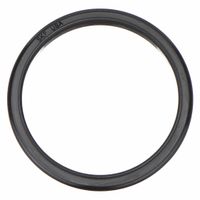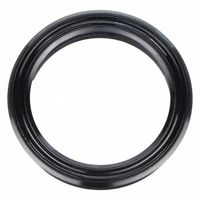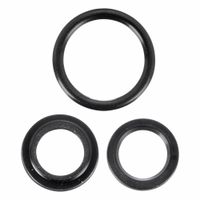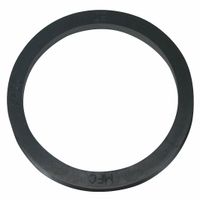Call +(254) 703 030 000 / 751 483 999 / 721 704 777
- Home
- Hydraulics
- Hydraulic Cylinders Seals
- Hydraulic Cylinder Seals
.....Read More
Frequently Asked Questions
What are the types of hydraulic cylinder seals?
Hydraulic cylinder seals are crucial components that prevent fluid leakage and maintain pressure within hydraulic systems. The main types include:
1. **Piston Seals**: These seals prevent fluid from leaking across the piston, ensuring efficient pressure build-up. They can be single-acting or double-acting, depending on the cylinder's design.
2. **Rod Seals**: Positioned at the cylinder's opening, rod seals prevent fluid leakage from the cylinder and protect against external contaminants. They are critical for maintaining the system's pressure and efficiency.
3. **Wiper Seals (Scraper Seals)**: These seals are located on the cylinder's external side and prevent dirt, dust, and other contaminants from entering the system, which could damage internal components.
4. **Buffer Seals**: Used in high-pressure applications, buffer seals are placed in front of the rod seal to absorb pressure spikes and protect the rod seal from excessive wear.
5. **Guide Rings (Wear Rings)**: These components are not seals but are essential for guiding the piston and rod, preventing metal-to-metal contact, and ensuring smooth operation.
6. **Static Seals**: These seals are used in non-moving parts of the cylinder, such as end caps, to prevent leakage at static interfaces.
7. **O-Rings**: Versatile and commonly used, O-rings provide sealing in both static and dynamic applications, often used in conjunction with other seal types for enhanced performance.
8. **Back-Up Rings**: These are used with O-rings to prevent extrusion under high pressure, enhancing the seal's durability and performance.
Each type of seal is designed to address specific challenges within hydraulic systems, such as pressure, temperature, and environmental conditions, ensuring optimal performance and longevity.
How do you replace hydraulic cylinder seals?
To replace hydraulic cylinder seals, follow these steps:
1. **Safety First**: Ensure the hydraulic system is depressurized and disconnected from power sources. Wear appropriate safety gear.
2. **Remove the Cylinder**: Detach the hydraulic cylinder from the machine. This may involve removing pins, bolts, or hoses. Label hoses for easy reassembly.
3. **Disassemble the Cylinder**: Secure the cylinder in a vice or on a stable workbench. Remove the rod end cap or gland using a spanner wrench or appropriate tool. Slide the rod assembly out of the cylinder barrel.
4. **Remove Old Seals**: Carefully extract old seals, O-rings, and wipers from the rod, gland, and piston using a seal pick or screwdriver. Note the order and orientation of each seal.
5. **Clean Components**: Thoroughly clean the rod, gland, piston, and cylinder barrel with a lint-free cloth and appropriate cleaning solution. Inspect for damage or wear.
6. **Install New Seals**: Lubricate new seals with hydraulic fluid. Install them in the reverse order of removal, ensuring correct orientation. Use a seal installation tool if necessary to avoid damage.
7. **Reassemble the Cylinder**: Slide the rod assembly back into the cylinder barrel. Reattach the rod end cap or gland, ensuring it is tightened to the manufacturer's specifications.
8. **Reinstall the Cylinder**: Reattach the cylinder to the machine, reconnecting hoses and securing with pins or bolts. Ensure all connections are tight and secure.
9. **Test the System**: Repressurize the hydraulic system and check for leaks. Operate the cylinder through its full range of motion to ensure proper function.
10. **Final Inspection**: Conduct a final inspection for leaks or abnormal operation. Make any necessary adjustments.
This process ensures the hydraulic cylinder operates efficiently and extends its service life.
What causes hydraulic cylinder seals to fail?
Hydraulic cylinder seals can fail due to several reasons:
1. **Contamination**: Dirt, debris, or metal particles in the hydraulic fluid can cause abrasion and wear on the seals, leading to failure.
2. **Improper Installation**: Incorrect installation can cause misalignment or damage to the seals, resulting in leaks or premature failure.
3. **Excessive Pressure**: Operating beyond the design pressure can cause the seals to extrude or blow out, leading to failure.
4. **Temperature Extremes**: High temperatures can cause seals to harden, crack, or lose elasticity, while low temperatures can make them brittle, both leading to failure.
5. **Chemical Degradation**: Exposure to incompatible hydraulic fluids or chemicals can cause the seals to swell, shrink, or degrade.
6. **Wear and Tear**: Normal wear over time can lead to seal degradation, especially if the seals are not regularly maintained or replaced.
7. **Improper Material Selection**: Using seals made from materials not suited for the specific hydraulic fluid or operating conditions can lead to premature failure.
8. **Mechanical Damage**: Physical damage from improper handling or external impacts can compromise seal integrity.
9. **Design Flaws**: Poor design of the hydraulic system or the seals themselves can lead to uneven pressure distribution or inadequate sealing.
10. **Vibration and Shock Loads**: Excessive vibration or shock can cause mechanical stress on the seals, leading to failure.
11. **Inadequate Lubrication**: Lack of proper lubrication can increase friction and wear on the seals.
12. **Aging**: Over time, seals can degrade due to natural aging processes, losing their elasticity and effectiveness.
Regular maintenance, proper installation, and using the right materials for specific conditions can help mitigate these issues and extend the life of hydraulic cylinder seals.
How do you measure hydraulic cylinder seals?
To measure hydraulic cylinder seals, follow these steps:
1. **Identify Seal Type**: Determine the type of seal (e.g., rod seal, piston seal, wiper seal) as each may have different measurement requirements.
2. **Disassemble Cylinder**: Safely disassemble the hydraulic cylinder to access the seals. Ensure the system is depressurized before starting.
3. **Clean Seals**: Clean the seals to remove any debris or oil that might affect measurements.
4. **Measure Seal Dimensions**:
- **Inner Diameter (ID)**: Use a caliper to measure the inner diameter of the seal. This is crucial for rod seals.
- **Outer Diameter (OD)**: Measure the outer diameter, which is important for piston seals.
- **Cross-Section**: Measure the thickness or cross-section of the seal. This is the distance from the inner to the outer edge of the seal.
5. **Check Groove Dimensions**:
- **Groove Diameter**: Measure the diameter of the groove where the seal sits.
- **Groove Width**: Measure the width of the groove to ensure the seal fits properly.
6. **Consider Seal Stretch**: Account for any stretch or deformation in used seals. Compare with manufacturer specifications for new seals.
7. **Material and Hardness**: Note the material and hardness of the seal, as these can affect performance and compatibility.
8. **Consult Manufacturer Specs**: Compare your measurements with the manufacturer's specifications to ensure accuracy and compatibility.
9. **Record Measurements**: Document all measurements for future reference or replacement purposes.
10. **Reassemble Cylinder**: Once measurements are complete, reassemble the cylinder, ensuring all components are correctly aligned and secured.
Accurate measurement is crucial for ensuring the proper fit and function of hydraulic seals, preventing leaks and maintaining system efficiency.
What materials are hydraulic cylinder seals made from?
Hydraulic cylinder seals are typically made from a variety of materials, each chosen for its specific properties that suit different applications and operating conditions. Common materials include:
1. **Nitrile Rubber (NBR):** Known for its excellent resistance to petroleum-based oils and fuels, NBR is widely used in hydraulic systems. It offers good abrasion resistance and tensile strength, making it suitable for general-purpose seals.
2. **Polyurethane (PU):** This material is highly resistant to wear and extrusion, making it ideal for high-pressure applications. Polyurethane seals are known for their durability and ability to maintain a tight seal under dynamic conditions.
3. **Fluorocarbon (Viton):** Viton seals are used in applications where high temperature and chemical resistance are required. They perform well in aggressive environments and can withstand a wide range of temperatures.
4. **Polytetrafluoroethylene (PTFE):** PTFE, commonly known as Teflon, is used for its low friction and excellent chemical resistance. It is often used in applications where minimal friction is crucial, such as in dynamic seals.
5. **Ethylene Propylene Diene Monomer (EPDM):** EPDM seals are resistant to weathering, ozone, and a wide range of chemicals. They are often used in applications involving water and steam.
6. **Silicone Rubber:** Known for its flexibility and temperature resistance, silicone is used in applications where extreme temperatures are a factor. However, it is not suitable for use with petroleum-based fluids.
7. **Hydrogenated Nitrile Butadiene Rubber (HNBR):** HNBR offers improved temperature and chemical resistance compared to standard NBR, making it suitable for more demanding applications.
Each material offers unique advantages and limitations, and the choice depends on factors such as temperature range, chemical exposure, pressure, and the specific requirements of the hydraulic system.
How do you install hydraulic cylinder seals?
To install hydraulic cylinder seals, follow these steps:
1. **Preparation**: Ensure the work area is clean and free of debris. Gather necessary tools such as seal picks, a seal installation tool, and lubricant. Wear safety gear.
2. **Disassembly**: Safely release any pressure in the hydraulic system. Remove the hydraulic cylinder from the machine. Disassemble the cylinder by removing the end cap, piston rod, and other components. Take note of the order and orientation of parts.
3. **Inspection**: Clean all components thoroughly. Inspect the cylinder, piston, and rod for wear or damage. Replace any damaged parts.
4. **Seal Removal**: Carefully remove old seals using a seal pick or similar tool. Avoid scratching or damaging the seal grooves.
5. **Seal Selection**: Ensure you have the correct replacement seals. Verify they match the specifications of the old seals.
6. **Seal Installation**:
- **Rod Seals**: Lubricate the new seal with hydraulic fluid. Use a seal installation tool to stretch and slide the seal over the rod into its groove.
- **Piston Seals**: Lubricate and install the piston seal by expanding it over the piston and into its groove. Use a seal installation tool to avoid twisting or damaging the seal.
- **Wiper Seals**: Install wiper seals at the end of the cylinder to prevent contaminants from entering.
7. **Reassembly**: Reassemble the cylinder components in the reverse order of disassembly. Ensure all seals are seated properly and components are aligned.
8. **Testing**: Reinstall the cylinder in the machine. Test the hydraulic system for leaks and proper operation. Monitor for any unusual noises or performance issues.
9. **Final Check**: After testing, perform a final inspection to ensure all components are secure and functioning correctly.
What are the symptoms of a bad hydraulic cylinder seal?
Symptoms of a bad hydraulic cylinder seal include:
1. **Fluid Leaks**: One of the most obvious signs is hydraulic fluid leaking from the cylinder. This can occur at the rod seal, piston seal, or any other seal within the cylinder.
2. **Reduced Performance**: A decrease in the efficiency of the hydraulic system, such as slower operation or reduced lifting capacity, can indicate seal failure.
3. **Pressure Loss**: Inability to maintain pressure within the hydraulic system, leading to erratic or weak performance.
4. **Contaminated Fluid**: Presence of dirt, debris, or water in the hydraulic fluid, which can be a result of seal failure allowing contaminants to enter the system.
5. **Excessive Heat**: Overheating of the hydraulic system due to increased friction or fluid leakage, which can be caused by worn or damaged seals.
6. **Unusual Noises**: Grinding, squealing, or other abnormal noises during operation can indicate seal issues.
7. **Rod Drift**: The hydraulic cylinder rod may drift or move when it should remain stationary, indicating internal leakage past the seals.
8. **Visible Damage**: Physical inspection may reveal cracks, tears, or other damage to the seals.
9. **Vibration**: Increased vibration during operation can be a sign of seal failure affecting the stability of the hydraulic system.
10. **Erratic Movement**: Jerky or inconsistent movement of the hydraulic cylinder can be a result of seal degradation.
11. **Increased Operating Costs**: Frequent need for fluid top-ups or maintenance can indicate underlying seal problems.
12. **Seal Extrusion**: Seals may appear to be pushed out of their grooves, indicating excessive pressure or improper installation.
Addressing these symptoms promptly can prevent further damage to the hydraulic system and ensure efficient operation.





